Impact of Macro-Environment on UBER's Business Strategy
VerifiedAdded on 2022/12/26
|18
|5146
|91
AI Summary
This report analyzes the impact of macro-environment on UBER's business strategy, including political, economic, social, technological, legal, and environmental factors. It also examines UBER's internal environment and capabilities, including strengths, weaknesses, opportunities, and threats.
Contribute Materials
Your contribution can guide someone’s learning journey. Share your
documents today.
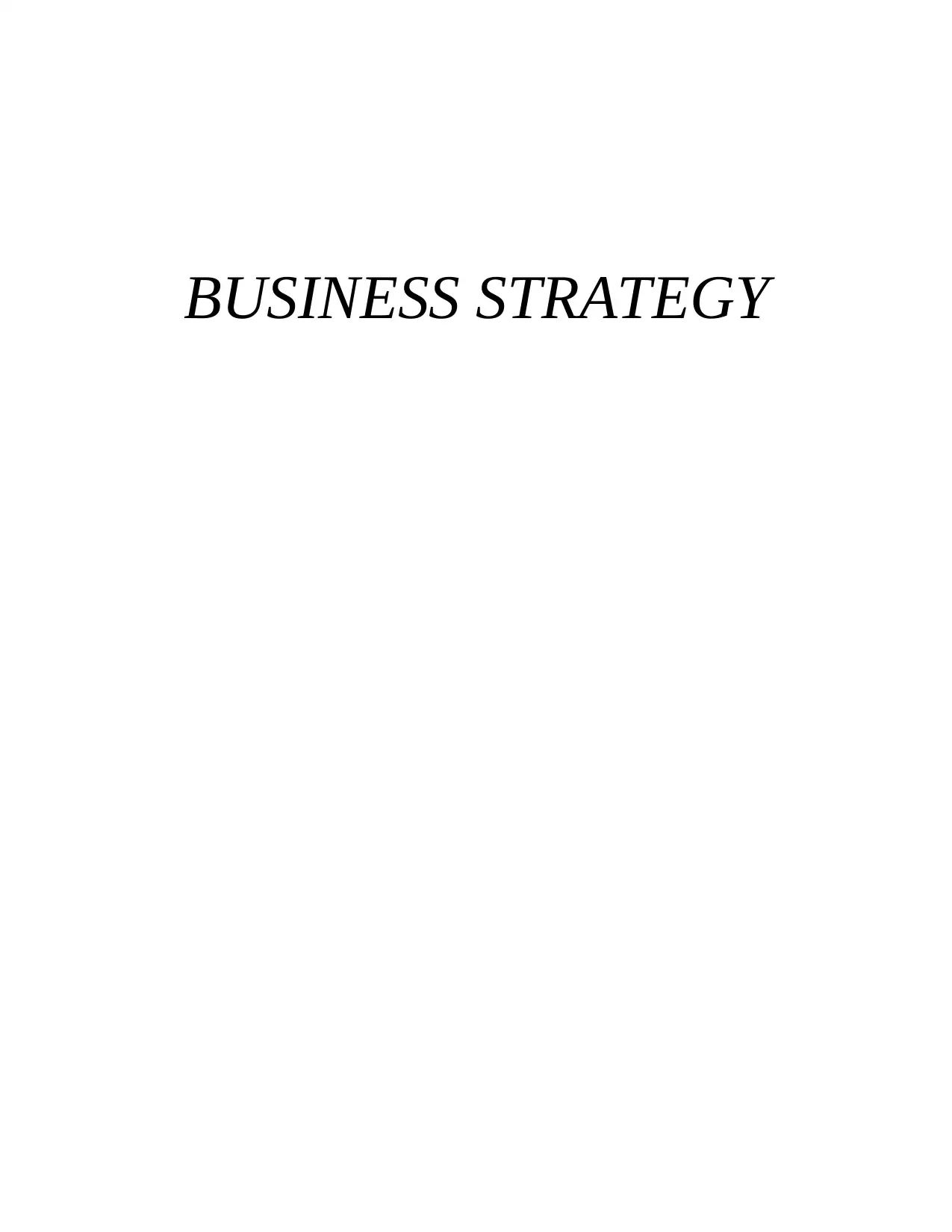
BUSINESS STRATEGY
Secure Best Marks with AI Grader
Need help grading? Try our AI Grader for instant feedback on your assignments.
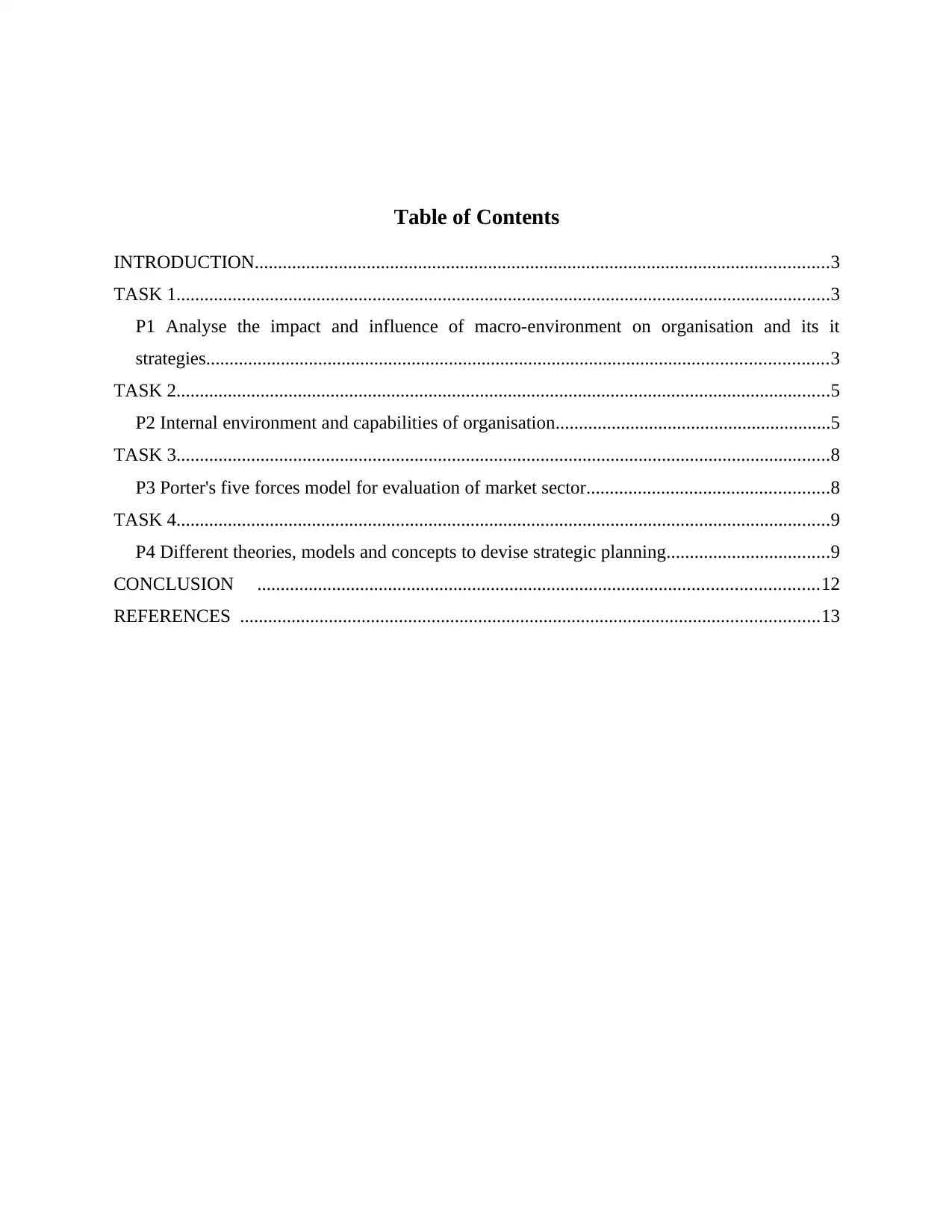
Table of Contents
INTRODUCTION...........................................................................................................................3
TASK 1............................................................................................................................................3
P1 Analyse the impact and influence of macro-environment on organisation and its it
strategies.....................................................................................................................................3
TASK 2............................................................................................................................................5
P2 Internal environment and capabilities of organisation...........................................................5
TASK 3............................................................................................................................................8
P3 Porter's five forces model for evaluation of market sector....................................................8
TASK 4............................................................................................................................................9
P4 Different theories, models and concepts to devise strategic planning...................................9
CONCLUSION ........................................................................................................................12
REFERENCES ............................................................................................................................13
INTRODUCTION...........................................................................................................................3
TASK 1............................................................................................................................................3
P1 Analyse the impact and influence of macro-environment on organisation and its it
strategies.....................................................................................................................................3
TASK 2............................................................................................................................................5
P2 Internal environment and capabilities of organisation...........................................................5
TASK 3............................................................................................................................................8
P3 Porter's five forces model for evaluation of market sector....................................................8
TASK 4............................................................................................................................................9
P4 Different theories, models and concepts to devise strategic planning...................................9
CONCLUSION ........................................................................................................................12
REFERENCES ............................................................................................................................13
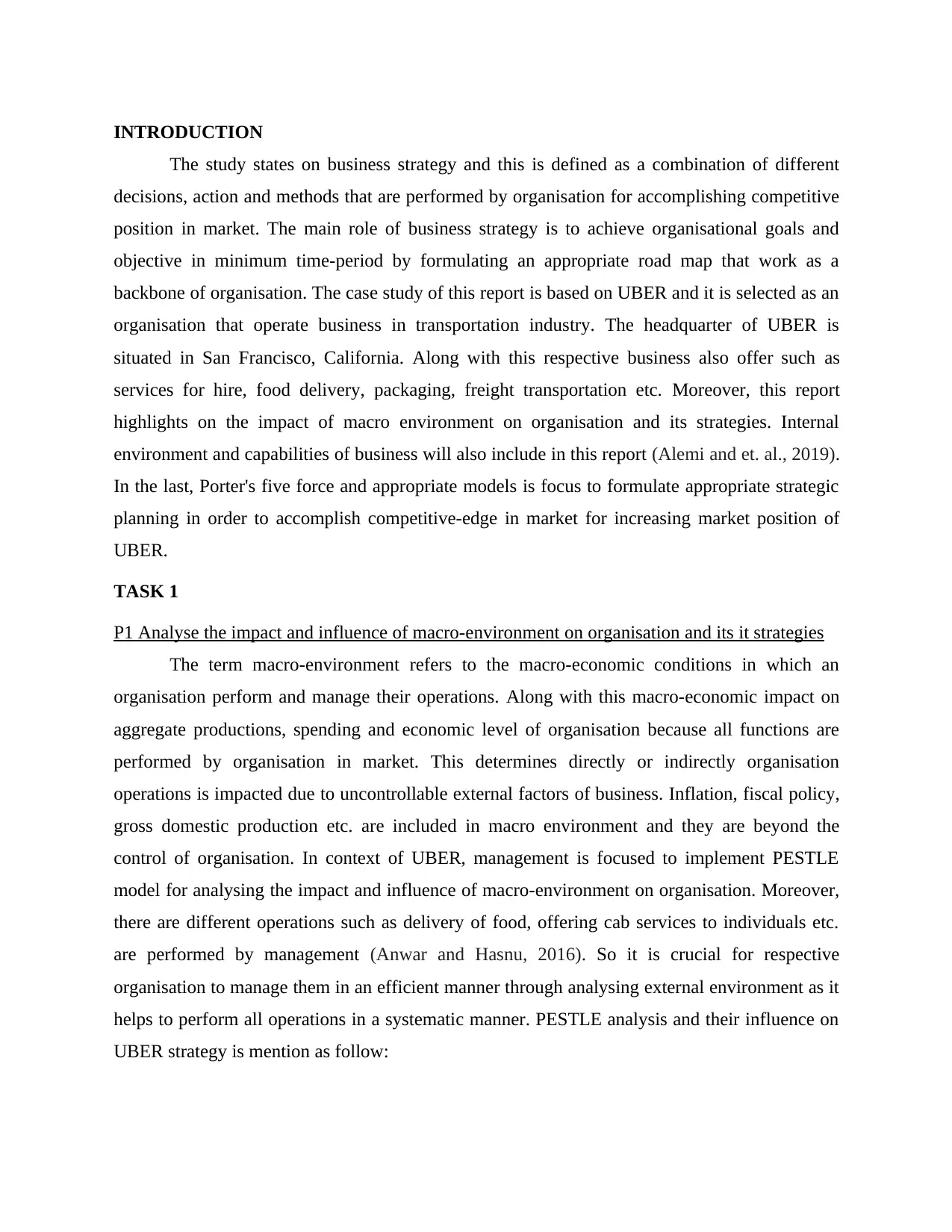
INTRODUCTION
The study states on business strategy and this is defined as a combination of different
decisions, action and methods that are performed by organisation for accomplishing competitive
position in market. The main role of business strategy is to achieve organisational goals and
objective in minimum time-period by formulating an appropriate road map that work as a
backbone of organisation. The case study of this report is based on UBER and it is selected as an
organisation that operate business in transportation industry. The headquarter of UBER is
situated in San Francisco, California. Along with this respective business also offer such as
services for hire, food delivery, packaging, freight transportation etc. Moreover, this report
highlights on the impact of macro environment on organisation and its strategies. Internal
environment and capabilities of business will also include in this report (Alemi and et. al., 2019).
In the last, Porter's five force and appropriate models is focus to formulate appropriate strategic
planning in order to accomplish competitive-edge in market for increasing market position of
UBER.
TASK 1
P1 Analyse the impact and influence of macro-environment on organisation and its it strategies
The term macro-environment refers to the macro-economic conditions in which an
organisation perform and manage their operations. Along with this macro-economic impact on
aggregate productions, spending and economic level of organisation because all functions are
performed by organisation in market. This determines directly or indirectly organisation
operations is impacted due to uncontrollable external factors of business. Inflation, fiscal policy,
gross domestic production etc. are included in macro environment and they are beyond the
control of organisation. In context of UBER, management is focused to implement PESTLE
model for analysing the impact and influence of macro-environment on organisation. Moreover,
there are different operations such as delivery of food, offering cab services to individuals etc.
are performed by management (Anwar and Hasnu, 2016). So it is crucial for respective
organisation to manage them in an efficient manner through analysing external environment as it
helps to perform all operations in a systematic manner. PESTLE analysis and their influence on
UBER strategy is mention as follow:
The study states on business strategy and this is defined as a combination of different
decisions, action and methods that are performed by organisation for accomplishing competitive
position in market. The main role of business strategy is to achieve organisational goals and
objective in minimum time-period by formulating an appropriate road map that work as a
backbone of organisation. The case study of this report is based on UBER and it is selected as an
organisation that operate business in transportation industry. The headquarter of UBER is
situated in San Francisco, California. Along with this respective business also offer such as
services for hire, food delivery, packaging, freight transportation etc. Moreover, this report
highlights on the impact of macro environment on organisation and its strategies. Internal
environment and capabilities of business will also include in this report (Alemi and et. al., 2019).
In the last, Porter's five force and appropriate models is focus to formulate appropriate strategic
planning in order to accomplish competitive-edge in market for increasing market position of
UBER.
TASK 1
P1 Analyse the impact and influence of macro-environment on organisation and its it strategies
The term macro-environment refers to the macro-economic conditions in which an
organisation perform and manage their operations. Along with this macro-economic impact on
aggregate productions, spending and economic level of organisation because all functions are
performed by organisation in market. This determines directly or indirectly organisation
operations is impacted due to uncontrollable external factors of business. Inflation, fiscal policy,
gross domestic production etc. are included in macro environment and they are beyond the
control of organisation. In context of UBER, management is focused to implement PESTLE
model for analysing the impact and influence of macro-environment on organisation. Moreover,
there are different operations such as delivery of food, offering cab services to individuals etc.
are performed by management (Anwar and Hasnu, 2016). So it is crucial for respective
organisation to manage them in an efficient manner through analysing external environment as it
helps to perform all operations in a systematic manner. PESTLE analysis and their influence on
UBER strategy is mention as follow:
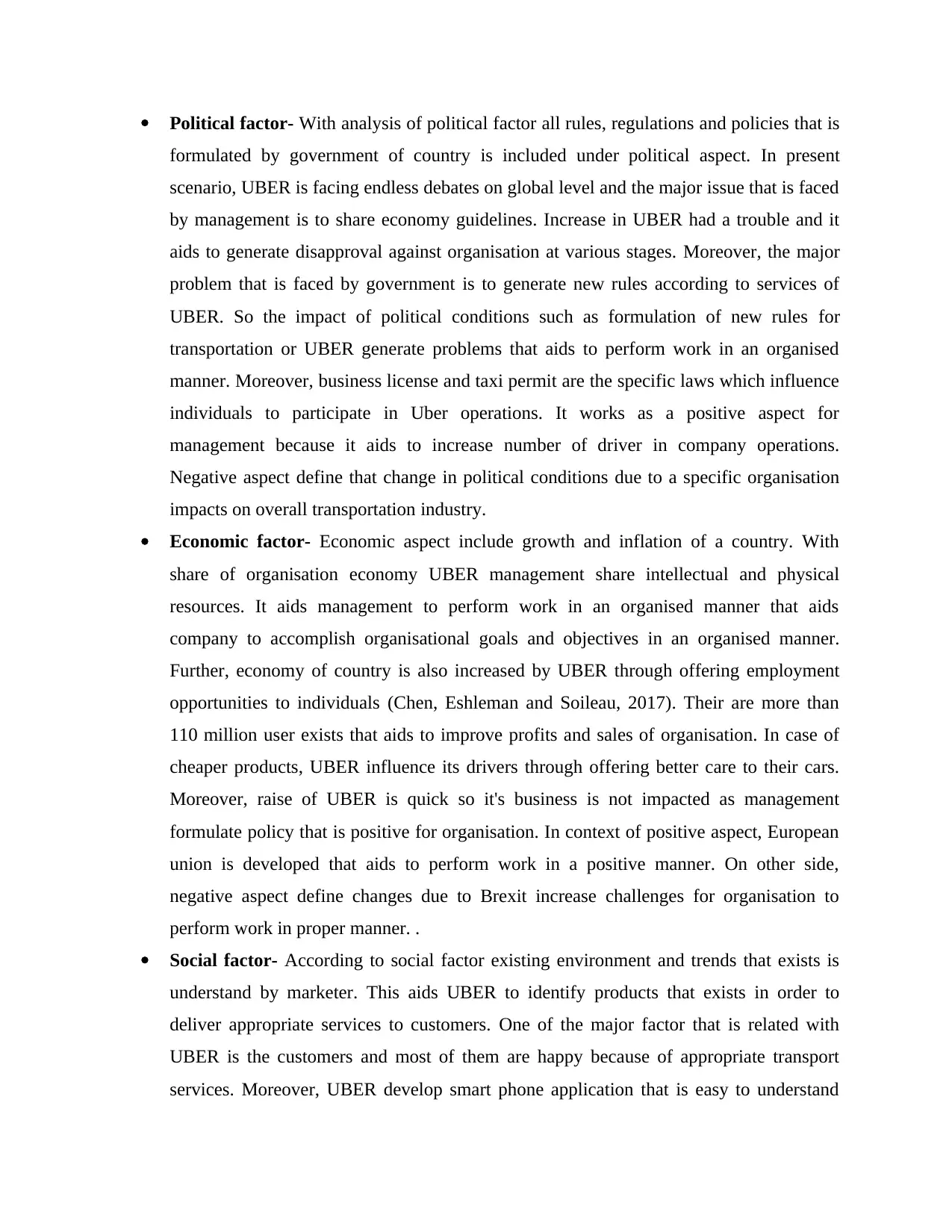
Political factor- With analysis of political factor all rules, regulations and policies that is
formulated by government of country is included under political aspect. In present
scenario, UBER is facing endless debates on global level and the major issue that is faced
by management is to share economy guidelines. Increase in UBER had a trouble and it
aids to generate disapproval against organisation at various stages. Moreover, the major
problem that is faced by government is to generate new rules according to services of
UBER. So the impact of political conditions such as formulation of new rules for
transportation or UBER generate problems that aids to perform work in an organised
manner. Moreover, business license and taxi permit are the specific laws which influence
individuals to participate in Uber operations. It works as a positive aspect for
management because it aids to increase number of driver in company operations.
Negative aspect define that change in political conditions due to a specific organisation
impacts on overall transportation industry.
Economic factor- Economic aspect include growth and inflation of a country. With
share of organisation economy UBER management share intellectual and physical
resources. It aids management to perform work in an organised manner that aids
company to accomplish organisational goals and objectives in an organised manner.
Further, economy of country is also increased by UBER through offering employment
opportunities to individuals (Chen, Eshleman and Soileau, 2017). Their are more than
110 million user exists that aids to improve profits and sales of organisation. In case of
cheaper products, UBER influence its drivers through offering better care to their cars.
Moreover, raise of UBER is quick so it's business is not impacted as management
formulate policy that is positive for organisation. In context of positive aspect, European
union is developed that aids to perform work in a positive manner. On other side,
negative aspect define changes due to Brexit increase challenges for organisation to
perform work in proper manner. .
Social factor- According to social factor existing environment and trends that exists is
understand by marketer. This aids UBER to identify products that exists in order to
deliver appropriate services to customers. One of the major factor that is related with
UBER is the customers and most of them are happy because of appropriate transport
services. Moreover, UBER develop smart phone application that is easy to understand
formulated by government of country is included under political aspect. In present
scenario, UBER is facing endless debates on global level and the major issue that is faced
by management is to share economy guidelines. Increase in UBER had a trouble and it
aids to generate disapproval against organisation at various stages. Moreover, the major
problem that is faced by government is to generate new rules according to services of
UBER. So the impact of political conditions such as formulation of new rules for
transportation or UBER generate problems that aids to perform work in an organised
manner. Moreover, business license and taxi permit are the specific laws which influence
individuals to participate in Uber operations. It works as a positive aspect for
management because it aids to increase number of driver in company operations.
Negative aspect define that change in political conditions due to a specific organisation
impacts on overall transportation industry.
Economic factor- Economic aspect include growth and inflation of a country. With
share of organisation economy UBER management share intellectual and physical
resources. It aids management to perform work in an organised manner that aids
company to accomplish organisational goals and objectives in an organised manner.
Further, economy of country is also increased by UBER through offering employment
opportunities to individuals (Chen, Eshleman and Soileau, 2017). Their are more than
110 million user exists that aids to improve profits and sales of organisation. In case of
cheaper products, UBER influence its drivers through offering better care to their cars.
Moreover, raise of UBER is quick so it's business is not impacted as management
formulate policy that is positive for organisation. In context of positive aspect, European
union is developed that aids to perform work in a positive manner. On other side,
negative aspect define changes due to Brexit increase challenges for organisation to
perform work in proper manner. .
Social factor- According to social factor existing environment and trends that exists is
understand by marketer. This aids UBER to identify products that exists in order to
deliver appropriate services to customers. One of the major factor that is related with
UBER is the customers and most of them are happy because of appropriate transport
services. Moreover, UBER develop smart phone application that is easy to understand
Secure Best Marks with AI Grader
Need help grading? Try our AI Grader for instant feedback on your assignments.
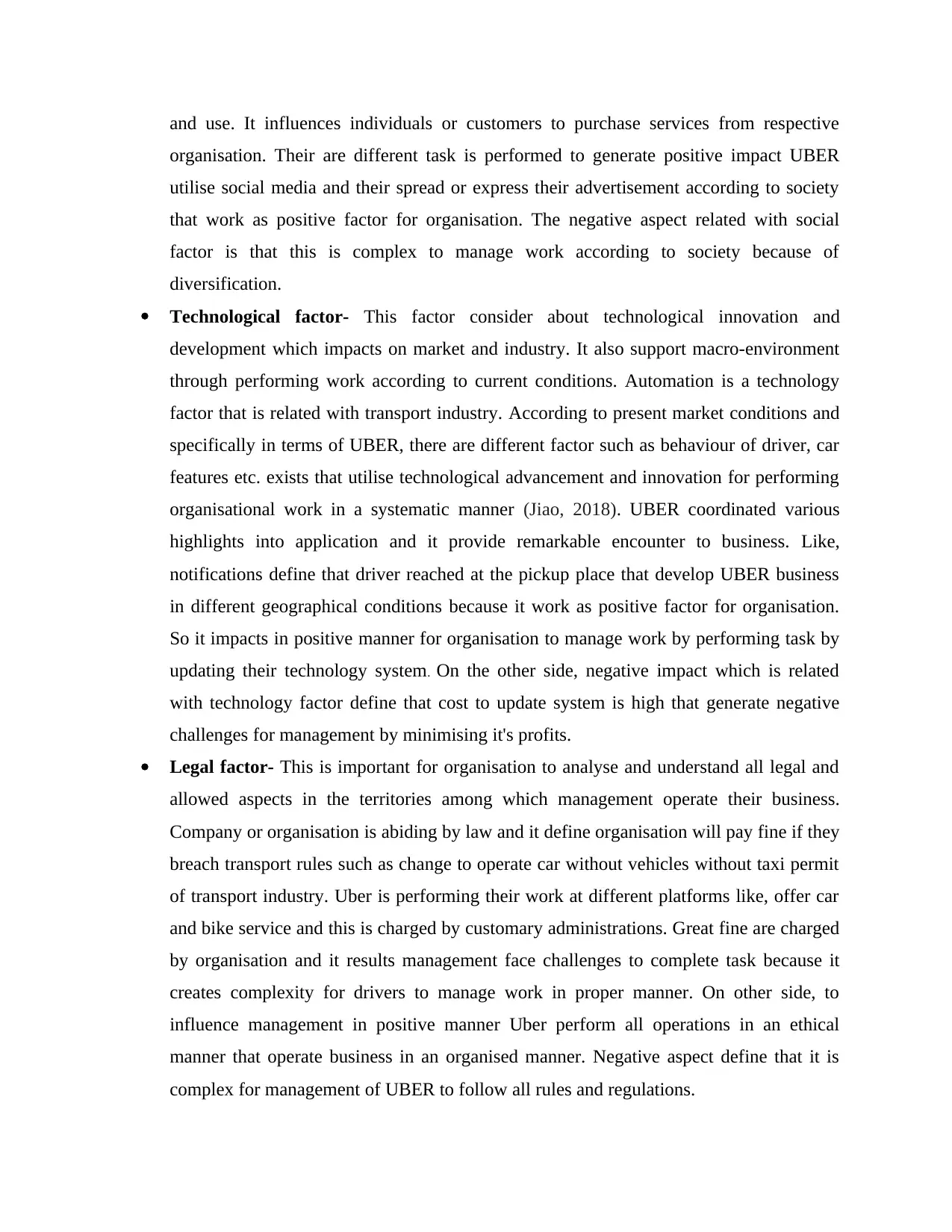
and use. It influences individuals or customers to purchase services from respective
organisation. Their are different task is performed to generate positive impact UBER
utilise social media and their spread or express their advertisement according to society
that work as positive factor for organisation. The negative aspect related with social
factor is that this is complex to manage work according to society because of
diversification.
Technological factor- This factor consider about technological innovation and
development which impacts on market and industry. It also support macro-environment
through performing work according to current conditions. Automation is a technology
factor that is related with transport industry. According to present market conditions and
specifically in terms of UBER, there are different factor such as behaviour of driver, car
features etc. exists that utilise technological advancement and innovation for performing
organisational work in a systematic manner (Jiao, 2018). UBER coordinated various
highlights into application and it provide remarkable encounter to business. Like,
notifications define that driver reached at the pickup place that develop UBER business
in different geographical conditions because it work as positive factor for organisation.
So it impacts in positive manner for organisation to manage work by performing task by
updating their technology system. On the other side, negative impact which is related
with technology factor define that cost to update system is high that generate negative
challenges for management by minimising it's profits.
Legal factor- This is important for organisation to analyse and understand all legal and
allowed aspects in the territories among which management operate their business.
Company or organisation is abiding by law and it define organisation will pay fine if they
breach transport rules such as change to operate car without vehicles without taxi permit
of transport industry. Uber is performing their work at different platforms like, offer car
and bike service and this is charged by customary administrations. Great fine are charged
by organisation and it results management face challenges to complete task because it
creates complexity for drivers to manage work in proper manner. On other side, to
influence management in positive manner Uber perform all operations in an ethical
manner that operate business in an organised manner. Negative aspect define that it is
complex for management of UBER to follow all rules and regulations.
organisation. Their are different task is performed to generate positive impact UBER
utilise social media and their spread or express their advertisement according to society
that work as positive factor for organisation. The negative aspect related with social
factor is that this is complex to manage work according to society because of
diversification.
Technological factor- This factor consider about technological innovation and
development which impacts on market and industry. It also support macro-environment
through performing work according to current conditions. Automation is a technology
factor that is related with transport industry. According to present market conditions and
specifically in terms of UBER, there are different factor such as behaviour of driver, car
features etc. exists that utilise technological advancement and innovation for performing
organisational work in a systematic manner (Jiao, 2018). UBER coordinated various
highlights into application and it provide remarkable encounter to business. Like,
notifications define that driver reached at the pickup place that develop UBER business
in different geographical conditions because it work as positive factor for organisation.
So it impacts in positive manner for organisation to manage work by performing task by
updating their technology system. On the other side, negative impact which is related
with technology factor define that cost to update system is high that generate negative
challenges for management by minimising it's profits.
Legal factor- This is important for organisation to analyse and understand all legal and
allowed aspects in the territories among which management operate their business.
Company or organisation is abiding by law and it define organisation will pay fine if they
breach transport rules such as change to operate car without vehicles without taxi permit
of transport industry. Uber is performing their work at different platforms like, offer car
and bike service and this is charged by customary administrations. Great fine are charged
by organisation and it results management face challenges to complete task because it
creates complexity for drivers to manage work in proper manner. On other side, to
influence management in positive manner Uber perform all operations in an ethical
manner that operate business in an organised manner. Negative aspect define that it is
complex for management of UBER to follow all rules and regulations.
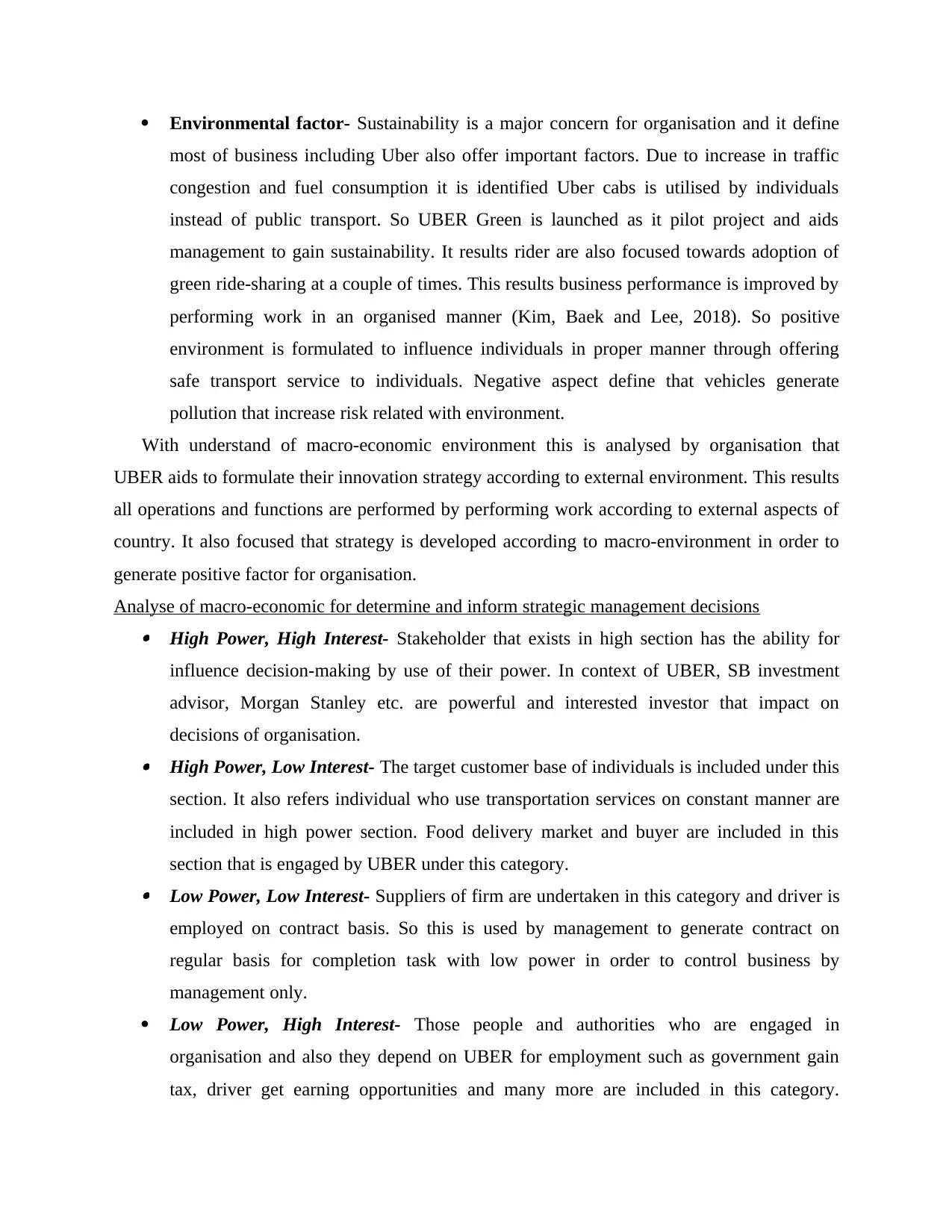
Environmental factor- Sustainability is a major concern for organisation and it define
most of business including Uber also offer important factors. Due to increase in traffic
congestion and fuel consumption it is identified Uber cabs is utilised by individuals
instead of public transport. So UBER Green is launched as it pilot project and aids
management to gain sustainability. It results rider are also focused towards adoption of
green ride-sharing at a couple of times. This results business performance is improved by
performing work in an organised manner (Kim, Baek and Lee, 2018). So positive
environment is formulated to influence individuals in proper manner through offering
safe transport service to individuals. Negative aspect define that vehicles generate
pollution that increase risk related with environment.
With understand of macro-economic environment this is analysed by organisation that
UBER aids to formulate their innovation strategy according to external environment. This results
all operations and functions are performed by performing work according to external aspects of
country. It also focused that strategy is developed according to macro-environment in order to
generate positive factor for organisation.
Analyse of macro-economic for determine and inform strategic management decisions High Power, High Interest- Stakeholder that exists in high section has the ability for
influence decision-making by use of their power. In context of UBER, SB investment
advisor, Morgan Stanley etc. are powerful and interested investor that impact on
decisions of organisation. High Power, Low Interest- The target customer base of individuals is included under this
section. It also refers individual who use transportation services on constant manner are
included in high power section. Food delivery market and buyer are included in this
section that is engaged by UBER under this category. Low Power, Low Interest- Suppliers of firm are undertaken in this category and driver is
employed on contract basis. So this is used by management to generate contract on
regular basis for completion task with low power in order to control business by
management only.
Low Power, High Interest- Those people and authorities who are engaged in
organisation and also they depend on UBER for employment such as government gain
tax, driver get earning opportunities and many more are included in this category.
most of business including Uber also offer important factors. Due to increase in traffic
congestion and fuel consumption it is identified Uber cabs is utilised by individuals
instead of public transport. So UBER Green is launched as it pilot project and aids
management to gain sustainability. It results rider are also focused towards adoption of
green ride-sharing at a couple of times. This results business performance is improved by
performing work in an organised manner (Kim, Baek and Lee, 2018). So positive
environment is formulated to influence individuals in proper manner through offering
safe transport service to individuals. Negative aspect define that vehicles generate
pollution that increase risk related with environment.
With understand of macro-economic environment this is analysed by organisation that
UBER aids to formulate their innovation strategy according to external environment. This results
all operations and functions are performed by performing work according to external aspects of
country. It also focused that strategy is developed according to macro-environment in order to
generate positive factor for organisation.
Analyse of macro-economic for determine and inform strategic management decisions High Power, High Interest- Stakeholder that exists in high section has the ability for
influence decision-making by use of their power. In context of UBER, SB investment
advisor, Morgan Stanley etc. are powerful and interested investor that impact on
decisions of organisation. High Power, Low Interest- The target customer base of individuals is included under this
section. It also refers individual who use transportation services on constant manner are
included in high power section. Food delivery market and buyer are included in this
section that is engaged by UBER under this category. Low Power, Low Interest- Suppliers of firm are undertaken in this category and driver is
employed on contract basis. So this is used by management to generate contract on
regular basis for completion task with low power in order to control business by
management only.
Low Power, High Interest- Those people and authorities who are engaged in
organisation and also they depend on UBER for employment such as government gain
tax, driver get earning opportunities and many more are included in this category.
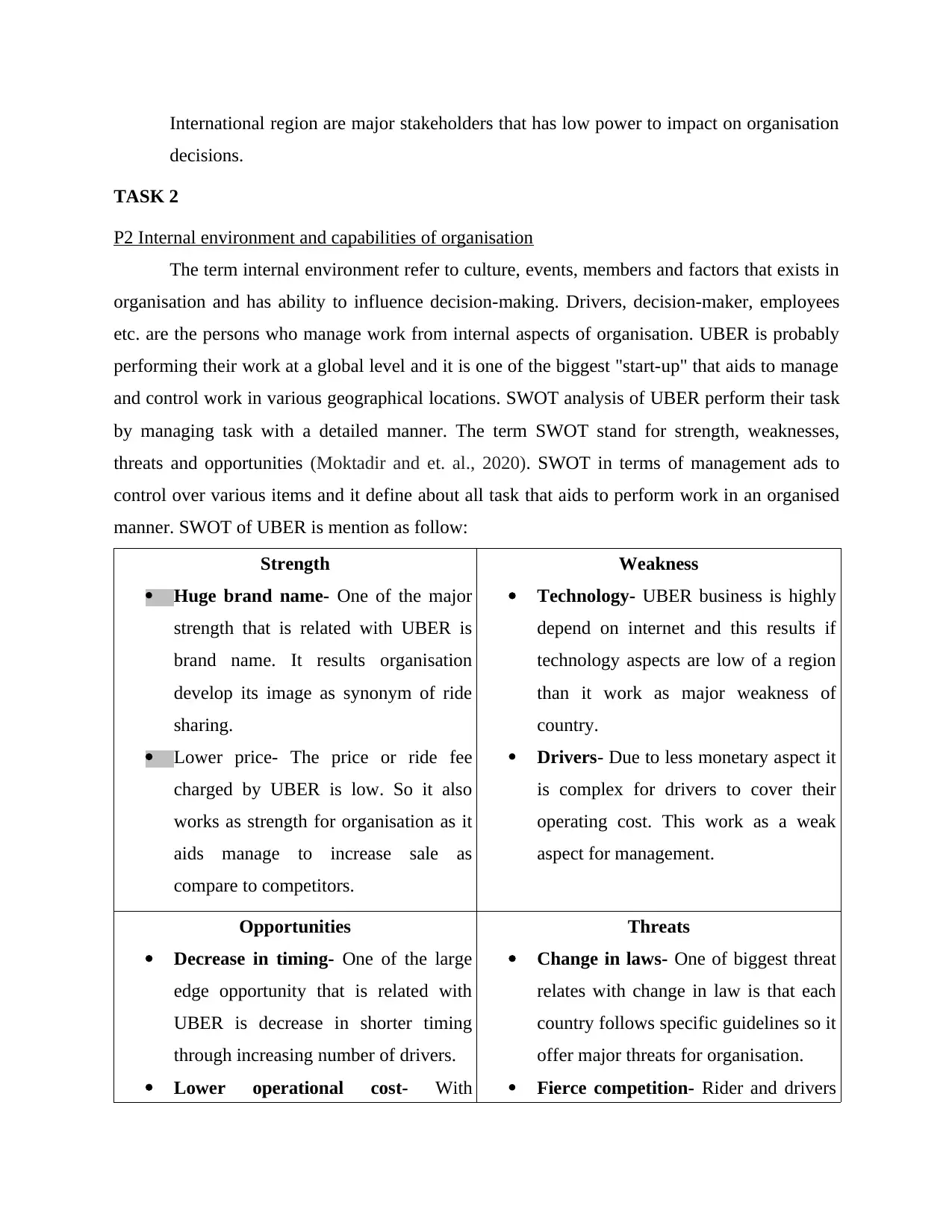
International region are major stakeholders that has low power to impact on organisation
decisions.
TASK 2
P2 Internal environment and capabilities of organisation
The term internal environment refer to culture, events, members and factors that exists in
organisation and has ability to influence decision-making. Drivers, decision-maker, employees
etc. are the persons who manage work from internal aspects of organisation. UBER is probably
performing their work at a global level and it is one of the biggest "start-up" that aids to manage
and control work in various geographical locations. SWOT analysis of UBER perform their task
by managing task with a detailed manner. The term SWOT stand for strength, weaknesses,
threats and opportunities (Moktadir and et. al., 2020). SWOT in terms of management ads to
control over various items and it define about all task that aids to perform work in an organised
manner. SWOT of UBER is mention as follow:
Strength
Huge brand name- One of the major
strength that is related with UBER is
brand name. It results organisation
develop its image as synonym of ride
sharing.
Lower price- The price or ride fee
charged by UBER is low. So it also
works as strength for organisation as it
aids manage to increase sale as
compare to competitors.
Weakness
Technology- UBER business is highly
depend on internet and this results if
technology aspects are low of a region
than it work as major weakness of
country.
Drivers- Due to less monetary aspect it
is complex for drivers to cover their
operating cost. This work as a weak
aspect for management.
Opportunities
Decrease in timing- One of the large
edge opportunity that is related with
UBER is decrease in shorter timing
through increasing number of drivers.
Lower operational cost- With
Threats
Change in laws- One of biggest threat
relates with change in law is that each
country follows specific guidelines so it
offer major threats for organisation.
Fierce competition- Rider and drivers
decisions.
TASK 2
P2 Internal environment and capabilities of organisation
The term internal environment refer to culture, events, members and factors that exists in
organisation and has ability to influence decision-making. Drivers, decision-maker, employees
etc. are the persons who manage work from internal aspects of organisation. UBER is probably
performing their work at a global level and it is one of the biggest "start-up" that aids to manage
and control work in various geographical locations. SWOT analysis of UBER perform their task
by managing task with a detailed manner. The term SWOT stand for strength, weaknesses,
threats and opportunities (Moktadir and et. al., 2020). SWOT in terms of management ads to
control over various items and it define about all task that aids to perform work in an organised
manner. SWOT of UBER is mention as follow:
Strength
Huge brand name- One of the major
strength that is related with UBER is
brand name. It results organisation
develop its image as synonym of ride
sharing.
Lower price- The price or ride fee
charged by UBER is low. So it also
works as strength for organisation as it
aids manage to increase sale as
compare to competitors.
Weakness
Technology- UBER business is highly
depend on internet and this results if
technology aspects are low of a region
than it work as major weakness of
country.
Drivers- Due to less monetary aspect it
is complex for drivers to cover their
operating cost. This work as a weak
aspect for management.
Opportunities
Decrease in timing- One of the large
edge opportunity that is related with
UBER is decrease in shorter timing
through increasing number of drivers.
Lower operational cost- With
Threats
Change in laws- One of biggest threat
relates with change in law is that each
country follows specific guidelines so it
offer major threats for organisation.
Fierce competition- Rider and drivers
Paraphrase This Document
Need a fresh take? Get an instant paraphrase of this document with our AI Paraphraser
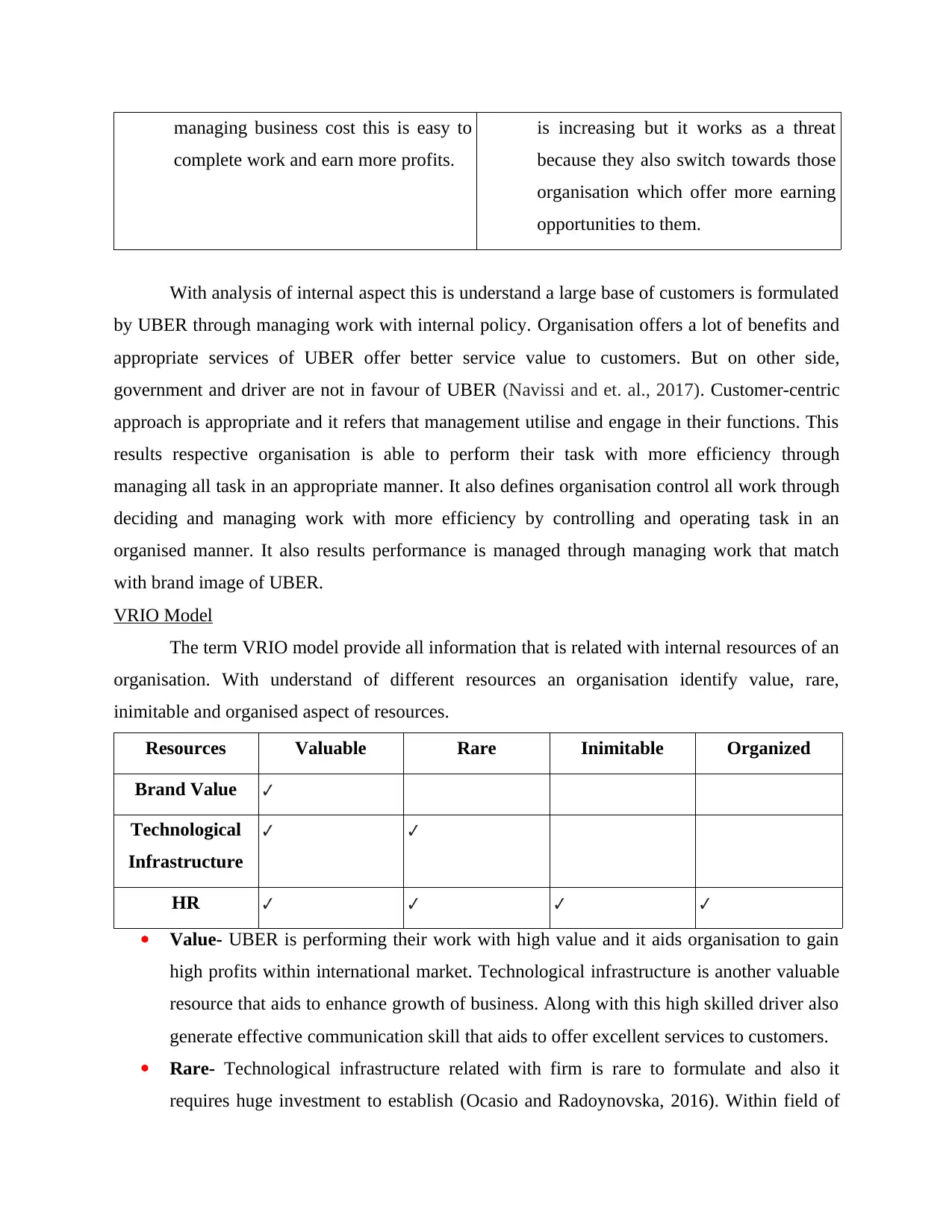
managing business cost this is easy to
complete work and earn more profits.
is increasing but it works as a threat
because they also switch towards those
organisation which offer more earning
opportunities to them.
With analysis of internal aspect this is understand a large base of customers is formulated
by UBER through managing work with internal policy. Organisation offers a lot of benefits and
appropriate services of UBER offer better service value to customers. But on other side,
government and driver are not in favour of UBER (Navissi and et. al., 2017). Customer-centric
approach is appropriate and it refers that management utilise and engage in their functions. This
results respective organisation is able to perform their task with more efficiency through
managing all task in an appropriate manner. It also defines organisation control all work through
deciding and managing work with more efficiency by controlling and operating task in an
organised manner. It also results performance is managed through managing work that match
with brand image of UBER.
VRIO Model
The term VRIO model provide all information that is related with internal resources of an
organisation. With understand of different resources an organisation identify value, rare,
inimitable and organised aspect of resources.
Resources Valuable Rare Inimitable Organized
Brand Value ✔
Technological
Infrastructure
✔ ✔
HR ✔ ✔ ✔ ✔
Value- UBER is performing their work with high value and it aids organisation to gain
high profits within international market. Technological infrastructure is another valuable
resource that aids to enhance growth of business. Along with this high skilled driver also
generate effective communication skill that aids to offer excellent services to customers.
Rare- Technological infrastructure related with firm is rare to formulate and also it
requires huge investment to establish (Ocasio and Radoynovska, 2016). Within field of
complete work and earn more profits.
is increasing but it works as a threat
because they also switch towards those
organisation which offer more earning
opportunities to them.
With analysis of internal aspect this is understand a large base of customers is formulated
by UBER through managing work with internal policy. Organisation offers a lot of benefits and
appropriate services of UBER offer better service value to customers. But on other side,
government and driver are not in favour of UBER (Navissi and et. al., 2017). Customer-centric
approach is appropriate and it refers that management utilise and engage in their functions. This
results respective organisation is able to perform their task with more efficiency through
managing all task in an appropriate manner. It also defines organisation control all work through
deciding and managing work with more efficiency by controlling and operating task in an
organised manner. It also results performance is managed through managing work that match
with brand image of UBER.
VRIO Model
The term VRIO model provide all information that is related with internal resources of an
organisation. With understand of different resources an organisation identify value, rare,
inimitable and organised aspect of resources.
Resources Valuable Rare Inimitable Organized
Brand Value ✔
Technological
Infrastructure
✔ ✔
HR ✔ ✔ ✔ ✔
Value- UBER is performing their work with high value and it aids organisation to gain
high profits within international market. Technological infrastructure is another valuable
resource that aids to enhance growth of business. Along with this high skilled driver also
generate effective communication skill that aids to offer excellent services to customers.
Rare- Technological infrastructure related with firm is rare to formulate and also it
requires huge investment to establish (Ocasio and Radoynovska, 2016). Within field of
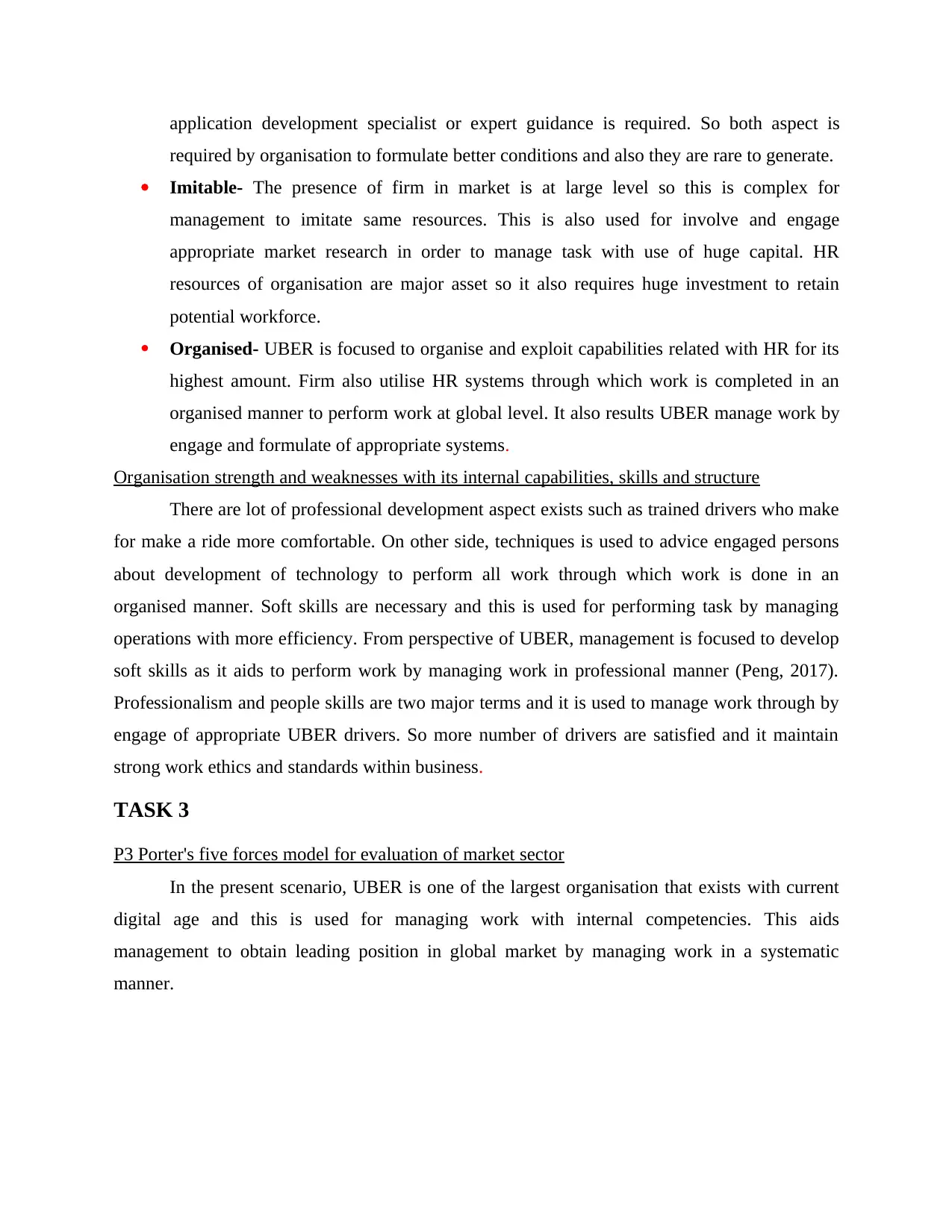
application development specialist or expert guidance is required. So both aspect is
required by organisation to formulate better conditions and also they are rare to generate.
Imitable- The presence of firm in market is at large level so this is complex for
management to imitate same resources. This is also used for involve and engage
appropriate market research in order to manage task with use of huge capital. HR
resources of organisation are major asset so it also requires huge investment to retain
potential workforce.
Organised- UBER is focused to organise and exploit capabilities related with HR for its
highest amount. Firm also utilise HR systems through which work is completed in an
organised manner to perform work at global level. It also results UBER manage work by
engage and formulate of appropriate systems.
Organisation strength and weaknesses with its internal capabilities, skills and structure
There are lot of professional development aspect exists such as trained drivers who make
for make a ride more comfortable. On other side, techniques is used to advice engaged persons
about development of technology to perform all work through which work is done in an
organised manner. Soft skills are necessary and this is used for performing task by managing
operations with more efficiency. From perspective of UBER, management is focused to develop
soft skills as it aids to perform work by managing work in professional manner (Peng, 2017).
Professionalism and people skills are two major terms and it is used to manage work through by
engage of appropriate UBER drivers. So more number of drivers are satisfied and it maintain
strong work ethics and standards within business.
TASK 3
P3 Porter's five forces model for evaluation of market sector
In the present scenario, UBER is one of the largest organisation that exists with current
digital age and this is used for managing work with internal competencies. This aids
management to obtain leading position in global market by managing work in a systematic
manner.
required by organisation to formulate better conditions and also they are rare to generate.
Imitable- The presence of firm in market is at large level so this is complex for
management to imitate same resources. This is also used for involve and engage
appropriate market research in order to manage task with use of huge capital. HR
resources of organisation are major asset so it also requires huge investment to retain
potential workforce.
Organised- UBER is focused to organise and exploit capabilities related with HR for its
highest amount. Firm also utilise HR systems through which work is completed in an
organised manner to perform work at global level. It also results UBER manage work by
engage and formulate of appropriate systems.
Organisation strength and weaknesses with its internal capabilities, skills and structure
There are lot of professional development aspect exists such as trained drivers who make
for make a ride more comfortable. On other side, techniques is used to advice engaged persons
about development of technology to perform all work through which work is done in an
organised manner. Soft skills are necessary and this is used for performing task by managing
operations with more efficiency. From perspective of UBER, management is focused to develop
soft skills as it aids to perform work by managing work in professional manner (Peng, 2017).
Professionalism and people skills are two major terms and it is used to manage work through by
engage of appropriate UBER drivers. So more number of drivers are satisfied and it maintain
strong work ethics and standards within business.
TASK 3
P3 Porter's five forces model for evaluation of market sector
In the present scenario, UBER is one of the largest organisation that exists with current
digital age and this is used for managing work with internal competencies. This aids
management to obtain leading position in global market by managing work in a systematic
manner.
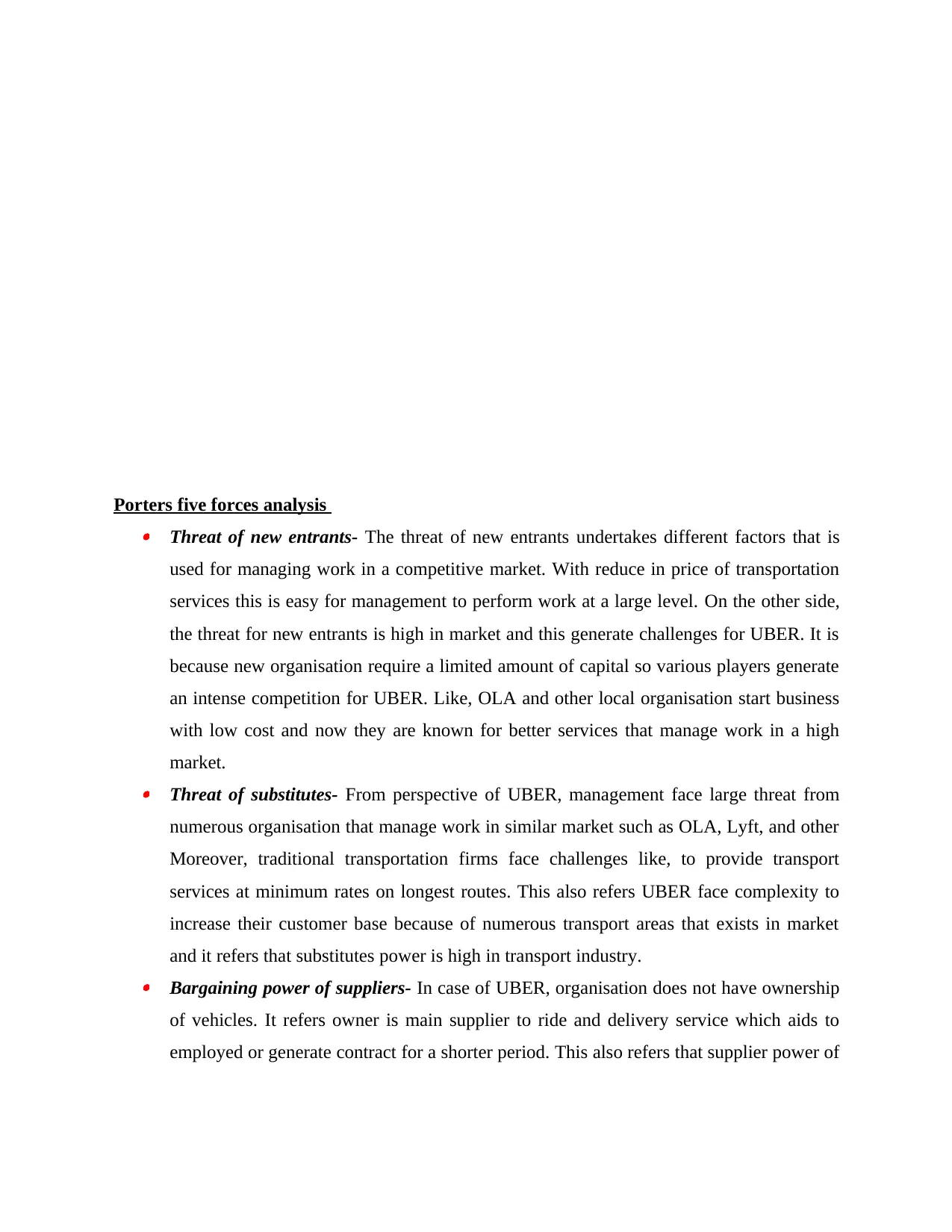
Porters five forces analysis Threat of new entrants- The threat of new entrants undertakes different factors that is
used for managing work in a competitive market. With reduce in price of transportation
services this is easy for management to perform work at a large level. On the other side,
the threat for new entrants is high in market and this generate challenges for UBER. It is
because new organisation require a limited amount of capital so various players generate
an intense competition for UBER. Like, OLA and other local organisation start business
with low cost and now they are known for better services that manage work in a high
market. Threat of substitutes- From perspective of UBER, management face large threat from
numerous organisation that manage work in similar market such as OLA, Lyft, and other
Moreover, traditional transportation firms face challenges like, to provide transport
services at minimum rates on longest routes. This also refers UBER face complexity to
increase their customer base because of numerous transport areas that exists in market
and it refers that substitutes power is high in transport industry. Bargaining power of suppliers- In case of UBER, organisation does not have ownership
of vehicles. It refers owner is main supplier to ride and delivery service which aids to
employed or generate contract for a shorter period. This also refers that supplier power of
used for managing work in a competitive market. With reduce in price of transportation
services this is easy for management to perform work at a large level. On the other side,
the threat for new entrants is high in market and this generate challenges for UBER. It is
because new organisation require a limited amount of capital so various players generate
an intense competition for UBER. Like, OLA and other local organisation start business
with low cost and now they are known for better services that manage work in a high
market. Threat of substitutes- From perspective of UBER, management face large threat from
numerous organisation that manage work in similar market such as OLA, Lyft, and other
Moreover, traditional transportation firms face challenges like, to provide transport
services at minimum rates on longest routes. This also refers UBER face complexity to
increase their customer base because of numerous transport areas that exists in market
and it refers that substitutes power is high in transport industry. Bargaining power of suppliers- In case of UBER, organisation does not have ownership
of vehicles. It refers owner is main supplier to ride and delivery service which aids to
employed or generate contract for a shorter period. This also refers that supplier power of
Secure Best Marks with AI Grader
Need help grading? Try our AI Grader for instant feedback on your assignments.

UBER is high. Supplier base of company is not proper and this generate to manage
bargaining power of supplier to manage organisational work. Bargaining power of consumers- UBER offer a lot of alternatives to their customers so
in case of individual’s price is managed by them through offering different options. In
context of customer base high bargaining power or force generate complexity for
organisation to earn high amount of profits. It refers that buyer power is high and to
manage buyer power UBER management utilise their low cost strategy.
Industry rivalry- UBER is facing an intense competition from the international and local
business. Like, OLA, Lyft and many more create issue that reduce market share as well
as profits of organisation.
With interpret of all Porter's five force an organisation identifies and generate overall profits by
shaping an appropriate strategy. This also refers to manage work with an organised channel
management complete task through imple This is also used by firm to measure all those aspects
that offer better aspects to obtain long term sustainability in market.
TASK 4
P4 Different theories, models and concepts to devise strategic planning
There is different task such as to provide transportation service, delivery of food etc. are
performed and with implement of appropriate strategies UBER perform their work in an
organised manner. Moreover, management perform work by analysis of different locations and it
aids to complete work within a selected market. Some strategies which is appropriate for UBER
is mention as follow:
Porters Generic Strategies
bargaining power of supplier to manage organisational work. Bargaining power of consumers- UBER offer a lot of alternatives to their customers so
in case of individual’s price is managed by them through offering different options. In
context of customer base high bargaining power or force generate complexity for
organisation to earn high amount of profits. It refers that buyer power is high and to
manage buyer power UBER management utilise their low cost strategy.
Industry rivalry- UBER is facing an intense competition from the international and local
business. Like, OLA, Lyft and many more create issue that reduce market share as well
as profits of organisation.
With interpret of all Porter's five force an organisation identifies and generate overall profits by
shaping an appropriate strategy. This also refers to manage work with an organised channel
management complete task through imple This is also used by firm to measure all those aspects
that offer better aspects to obtain long term sustainability in market.
TASK 4
P4 Different theories, models and concepts to devise strategic planning
There is different task such as to provide transportation service, delivery of food etc. are
performed and with implement of appropriate strategies UBER perform their work in an
organised manner. Moreover, management perform work by analysis of different locations and it
aids to complete work within a selected market. Some strategies which is appropriate for UBER
is mention as follow:
Porters Generic Strategies
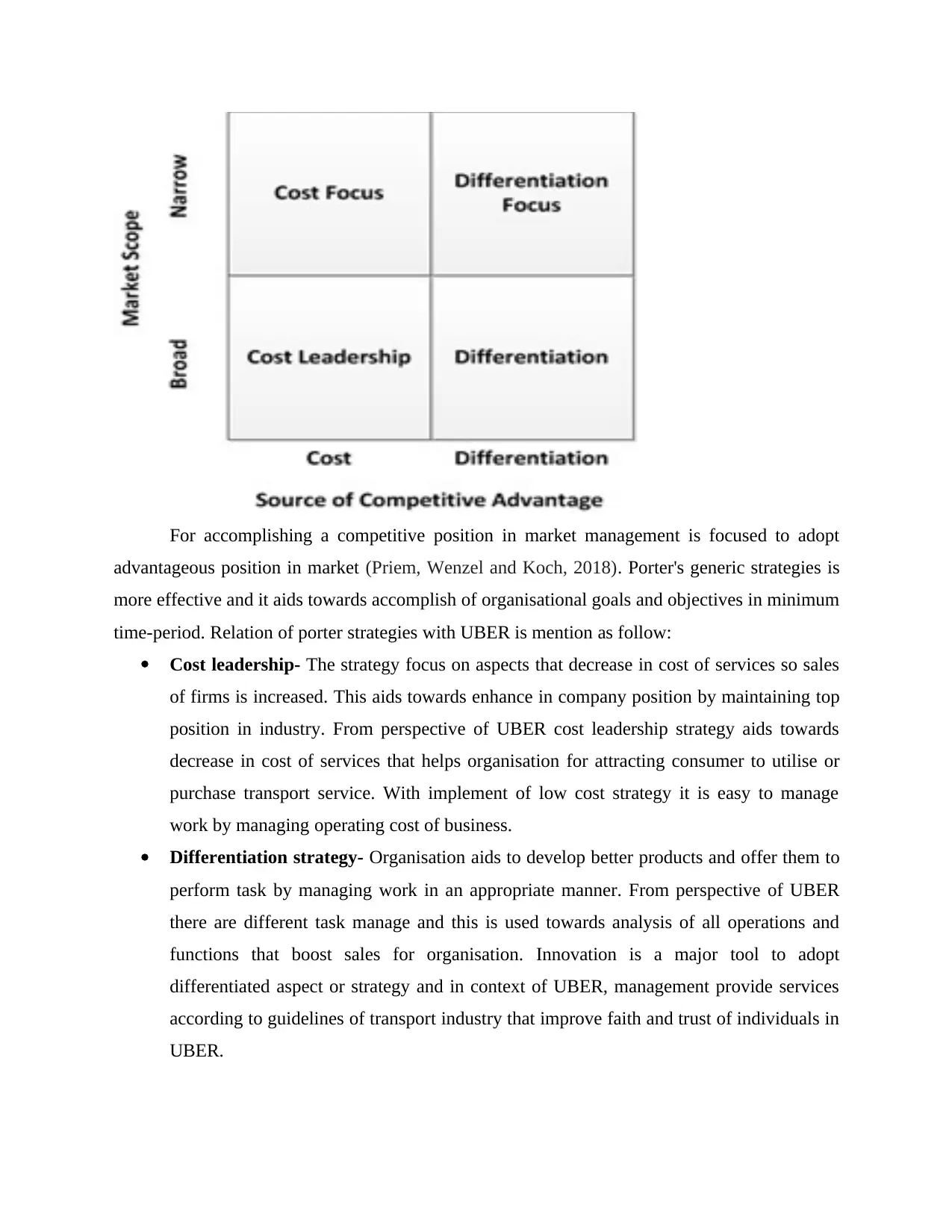
For accomplishing a competitive position in market management is focused to adopt
advantageous position in market (Priem, Wenzel and Koch, 2018). Porter's generic strategies is
more effective and it aids towards accomplish of organisational goals and objectives in minimum
time-period. Relation of porter strategies with UBER is mention as follow:
Cost leadership- The strategy focus on aspects that decrease in cost of services so sales
of firms is increased. This aids towards enhance in company position by maintaining top
position in industry. From perspective of UBER cost leadership strategy aids towards
decrease in cost of services that helps organisation for attracting consumer to utilise or
purchase transport service. With implement of low cost strategy it is easy to manage
work by managing operating cost of business.
Differentiation strategy- Organisation aids to develop better products and offer them to
perform task by managing work in an appropriate manner. From perspective of UBER
there are different task manage and this is used towards analysis of all operations and
functions that boost sales for organisation. Innovation is a major tool to adopt
differentiated aspect or strategy and in context of UBER, management provide services
according to guidelines of transport industry that improve faith and trust of individuals in
UBER.
advantageous position in market (Priem, Wenzel and Koch, 2018). Porter's generic strategies is
more effective and it aids towards accomplish of organisational goals and objectives in minimum
time-period. Relation of porter strategies with UBER is mention as follow:
Cost leadership- The strategy focus on aspects that decrease in cost of services so sales
of firms is increased. This aids towards enhance in company position by maintaining top
position in industry. From perspective of UBER cost leadership strategy aids towards
decrease in cost of services that helps organisation for attracting consumer to utilise or
purchase transport service. With implement of low cost strategy it is easy to manage
work by managing operating cost of business.
Differentiation strategy- Organisation aids to develop better products and offer them to
perform task by managing work in an appropriate manner. From perspective of UBER
there are different task manage and this is used towards analysis of all operations and
functions that boost sales for organisation. Innovation is a major tool to adopt
differentiated aspect or strategy and in context of UBER, management provide services
according to guidelines of transport industry that improve faith and trust of individuals in
UBER.

Focus strategy- The term focus strategy is centralized towards satisfying customers. It is
used for managing needs and expectations of a target market by implement of focus
strategy within business. Moreover, there are different commodities such as transfer of
services exists and they are used for satisfying unique needs. From perspective of UBER,
management offer services that cater needs of target market in order to obtain
competitive position in market (Remane and et. al., 2017). This also relates with aspects
of increasing position in market by offering desired products in market.
With understand of Porter generic strategy, it is identified that cost leadership strategy is
implemented by organisation. This is because management of UBER is performing their work at
global level. So a lot of investment is required by the organisation and with low cost it is easy for
management to manage all task with low cost system.
Bowman's Strategic Clock
The Bowman strategic model identify various strategic procedures and postpositions of
organisation. This is stated around different terms through which products and services are
offered in order to aids additional value. It results consumer are able to purchase product by
understand of product value. Different strategic positions in context of UBER is mention as
follow:
Low price and low value- The strategic position increase profitability of organisation
through offering products that are low valued and price.
used for managing needs and expectations of a target market by implement of focus
strategy within business. Moreover, there are different commodities such as transfer of
services exists and they are used for satisfying unique needs. From perspective of UBER,
management offer services that cater needs of target market in order to obtain
competitive position in market (Remane and et. al., 2017). This also relates with aspects
of increasing position in market by offering desired products in market.
With understand of Porter generic strategy, it is identified that cost leadership strategy is
implemented by organisation. This is because management of UBER is performing their work at
global level. So a lot of investment is required by the organisation and with low cost it is easy for
management to manage all task with low cost system.
Bowman's Strategic Clock
The Bowman strategic model identify various strategic procedures and postpositions of
organisation. This is stated around different terms through which products and services are
offered in order to aids additional value. It results consumer are able to purchase product by
understand of product value. Different strategic positions in context of UBER is mention as
follow:
Low price and low value- The strategic position increase profitability of organisation
through offering products that are low valued and price.
Paraphrase This Document
Need a fresh take? Get an instant paraphrase of this document with our AI Paraphraser
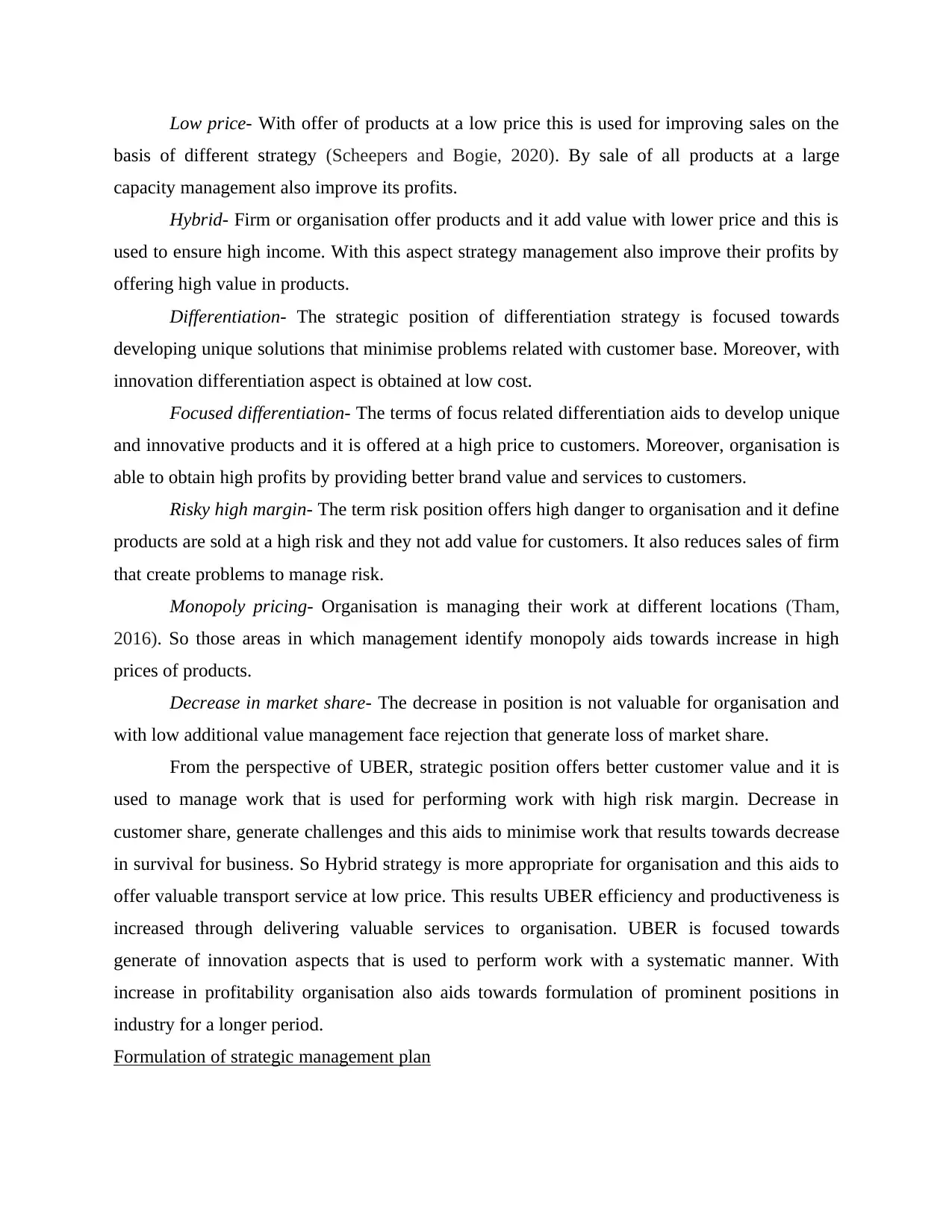
Low price- With offer of products at a low price this is used for improving sales on the
basis of different strategy (Scheepers and Bogie, 2020). By sale of all products at a large
capacity management also improve its profits.
Hybrid- Firm or organisation offer products and it add value with lower price and this is
used to ensure high income. With this aspect strategy management also improve their profits by
offering high value in products.
Differentiation- The strategic position of differentiation strategy is focused towards
developing unique solutions that minimise problems related with customer base. Moreover, with
innovation differentiation aspect is obtained at low cost.
Focused differentiation- The terms of focus related differentiation aids to develop unique
and innovative products and it is offered at a high price to customers. Moreover, organisation is
able to obtain high profits by providing better brand value and services to customers.
Risky high margin- The term risk position offers high danger to organisation and it define
products are sold at a high risk and they not add value for customers. It also reduces sales of firm
that create problems to manage risk.
Monopoly pricing- Organisation is managing their work at different locations (Tham,
2016). So those areas in which management identify monopoly aids towards increase in high
prices of products.
Decrease in market share- The decrease in position is not valuable for organisation and
with low additional value management face rejection that generate loss of market share.
From the perspective of UBER, strategic position offers better customer value and it is
used to manage work that is used for performing work with high risk margin. Decrease in
customer share, generate challenges and this aids to minimise work that results towards decrease
in survival for business. So Hybrid strategy is more appropriate for organisation and this aids to
offer valuable transport service at low price. This results UBER efficiency and productiveness is
increased through delivering valuable services to organisation. UBER is focused towards
generate of innovation aspects that is used to perform work with a systematic manner. With
increase in profitability organisation also aids towards formulation of prominent positions in
industry for a longer period.
Formulation of strategic management plan
basis of different strategy (Scheepers and Bogie, 2020). By sale of all products at a large
capacity management also improve its profits.
Hybrid- Firm or organisation offer products and it add value with lower price and this is
used to ensure high income. With this aspect strategy management also improve their profits by
offering high value in products.
Differentiation- The strategic position of differentiation strategy is focused towards
developing unique solutions that minimise problems related with customer base. Moreover, with
innovation differentiation aspect is obtained at low cost.
Focused differentiation- The terms of focus related differentiation aids to develop unique
and innovative products and it is offered at a high price to customers. Moreover, organisation is
able to obtain high profits by providing better brand value and services to customers.
Risky high margin- The term risk position offers high danger to organisation and it define
products are sold at a high risk and they not add value for customers. It also reduces sales of firm
that create problems to manage risk.
Monopoly pricing- Organisation is managing their work at different locations (Tham,
2016). So those areas in which management identify monopoly aids towards increase in high
prices of products.
Decrease in market share- The decrease in position is not valuable for organisation and
with low additional value management face rejection that generate loss of market share.
From the perspective of UBER, strategic position offers better customer value and it is
used to manage work that is used for performing work with high risk margin. Decrease in
customer share, generate challenges and this aids to minimise work that results towards decrease
in survival for business. So Hybrid strategy is more appropriate for organisation and this aids to
offer valuable transport service at low price. This results UBER efficiency and productiveness is
increased through delivering valuable services to organisation. UBER is focused towards
generate of innovation aspects that is used to perform work with a systematic manner. With
increase in profitability organisation also aids towards formulation of prominent positions in
industry for a longer period.
Formulation of strategic management plan
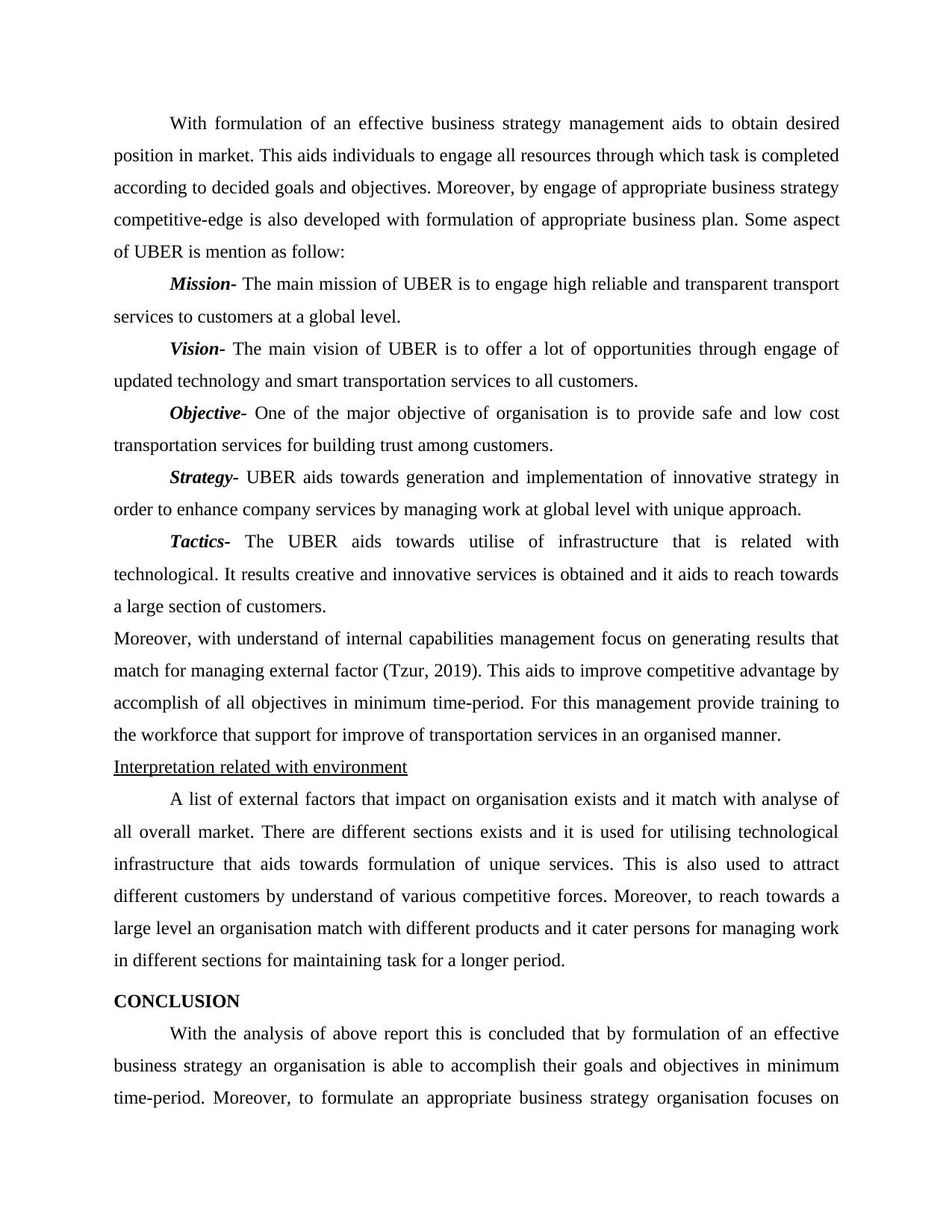
With formulation of an effective business strategy management aids to obtain desired
position in market. This aids individuals to engage all resources through which task is completed
according to decided goals and objectives. Moreover, by engage of appropriate business strategy
competitive-edge is also developed with formulation of appropriate business plan. Some aspect
of UBER is mention as follow:
Mission- The main mission of UBER is to engage high reliable and transparent transport
services to customers at a global level.
Vision- The main vision of UBER is to offer a lot of opportunities through engage of
updated technology and smart transportation services to all customers.
Objective- One of the major objective of organisation is to provide safe and low cost
transportation services for building trust among customers.
Strategy- UBER aids towards generation and implementation of innovative strategy in
order to enhance company services by managing work at global level with unique approach.
Tactics- The UBER aids towards utilise of infrastructure that is related with
technological. It results creative and innovative services is obtained and it aids to reach towards
a large section of customers.
Moreover, with understand of internal capabilities management focus on generating results that
match for managing external factor (Tzur, 2019). This aids to improve competitive advantage by
accomplish of all objectives in minimum time-period. For this management provide training to
the workforce that support for improve of transportation services in an organised manner.
Interpretation related with environment
A list of external factors that impact on organisation exists and it match with analyse of
all overall market. There are different sections exists and it is used for utilising technological
infrastructure that aids towards formulation of unique services. This is also used to attract
different customers by understand of various competitive forces. Moreover, to reach towards a
large level an organisation match with different products and it cater persons for managing work
in different sections for maintaining task for a longer period.
CONCLUSION
With the analysis of above report this is concluded that by formulation of an effective
business strategy an organisation is able to accomplish their goals and objectives in minimum
time-period. Moreover, to formulate an appropriate business strategy organisation focuses on
position in market. This aids individuals to engage all resources through which task is completed
according to decided goals and objectives. Moreover, by engage of appropriate business strategy
competitive-edge is also developed with formulation of appropriate business plan. Some aspect
of UBER is mention as follow:
Mission- The main mission of UBER is to engage high reliable and transparent transport
services to customers at a global level.
Vision- The main vision of UBER is to offer a lot of opportunities through engage of
updated technology and smart transportation services to all customers.
Objective- One of the major objective of organisation is to provide safe and low cost
transportation services for building trust among customers.
Strategy- UBER aids towards generation and implementation of innovative strategy in
order to enhance company services by managing work at global level with unique approach.
Tactics- The UBER aids towards utilise of infrastructure that is related with
technological. It results creative and innovative services is obtained and it aids to reach towards
a large section of customers.
Moreover, with understand of internal capabilities management focus on generating results that
match for managing external factor (Tzur, 2019). This aids to improve competitive advantage by
accomplish of all objectives in minimum time-period. For this management provide training to
the workforce that support for improve of transportation services in an organised manner.
Interpretation related with environment
A list of external factors that impact on organisation exists and it match with analyse of
all overall market. There are different sections exists and it is used for utilising technological
infrastructure that aids towards formulation of unique services. This is also used to attract
different customers by understand of various competitive forces. Moreover, to reach towards a
large level an organisation match with different products and it cater persons for managing work
in different sections for maintaining task for a longer period.
CONCLUSION
With the analysis of above report this is concluded that by formulation of an effective
business strategy an organisation is able to accomplish their goals and objectives in minimum
time-period. Moreover, to formulate an appropriate business strategy organisation focuses on
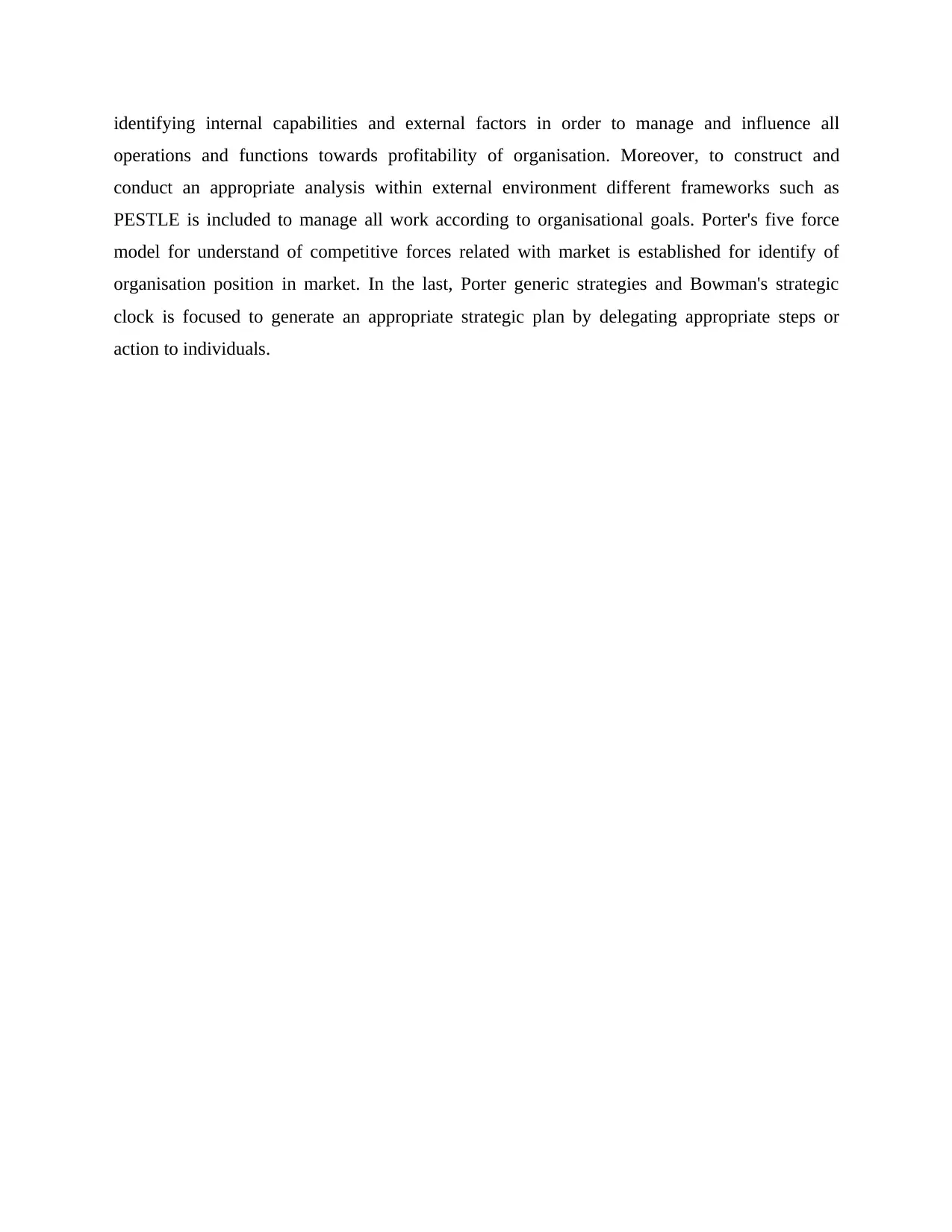
identifying internal capabilities and external factors in order to manage and influence all
operations and functions towards profitability of organisation. Moreover, to construct and
conduct an appropriate analysis within external environment different frameworks such as
PESTLE is included to manage all work according to organisational goals. Porter's five force
model for understand of competitive forces related with market is established for identify of
organisation position in market. In the last, Porter generic strategies and Bowman's strategic
clock is focused to generate an appropriate strategic plan by delegating appropriate steps or
action to individuals.
operations and functions towards profitability of organisation. Moreover, to construct and
conduct an appropriate analysis within external environment different frameworks such as
PESTLE is included to manage all work according to organisational goals. Porter's five force
model for understand of competitive forces related with market is established for identify of
organisation position in market. In the last, Porter generic strategies and Bowman's strategic
clock is focused to generate an appropriate strategic plan by delegating appropriate steps or
action to individuals.
Secure Best Marks with AI Grader
Need help grading? Try our AI Grader for instant feedback on your assignments.
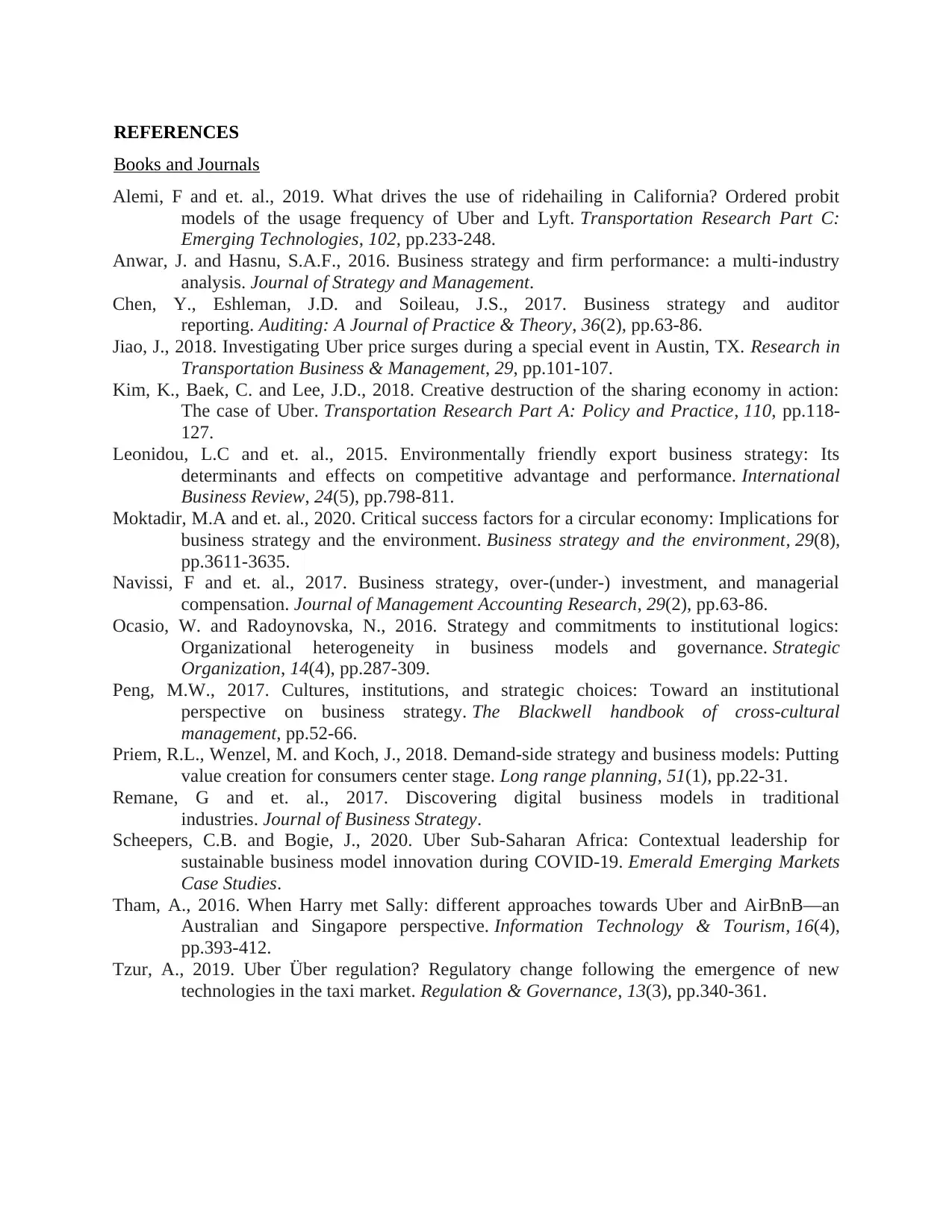
REFERENCES
Books and Journals
Alemi, F and et. al., 2019. What drives the use of ridehailing in California? Ordered probit
models of the usage frequency of Uber and Lyft. Transportation Research Part C:
Emerging Technologies, 102, pp.233-248.
Anwar, J. and Hasnu, S.A.F., 2016. Business strategy and firm performance: a multi-industry
analysis. Journal of Strategy and Management.
Chen, Y., Eshleman, J.D. and Soileau, J.S., 2017. Business strategy and auditor
reporting. Auditing: A Journal of Practice & Theory, 36(2), pp.63-86.
Jiao, J., 2018. Investigating Uber price surges during a special event in Austin, TX. Research in
Transportation Business & Management, 29, pp.101-107.
Kim, K., Baek, C. and Lee, J.D., 2018. Creative destruction of the sharing economy in action:
The case of Uber. Transportation Research Part A: Policy and Practice, 110, pp.118-
127.
Leonidou, L.C and et. al., 2015. Environmentally friendly export business strategy: Its
determinants and effects on competitive advantage and performance. International
Business Review, 24(5), pp.798-811.
Moktadir, M.A and et. al., 2020. Critical success factors for a circular economy: Implications for
business strategy and the environment. Business strategy and the environment, 29(8),
pp.3611-3635.
Navissi, F and et. al., 2017. Business strategy, over-(under-) investment, and managerial
compensation. Journal of Management Accounting Research, 29(2), pp.63-86.
Ocasio, W. and Radoynovska, N., 2016. Strategy and commitments to institutional logics:
Organizational heterogeneity in business models and governance. Strategic
Organization, 14(4), pp.287-309.
Peng, M.W., 2017. Cultures, institutions, and strategic choices: Toward an institutional
perspective on business strategy. The Blackwell handbook of cross‐cultural
management, pp.52-66.
Priem, R.L., Wenzel, M. and Koch, J., 2018. Demand-side strategy and business models: Putting
value creation for consumers center stage. Long range planning, 51(1), pp.22-31.
Remane, G and et. al., 2017. Discovering digital business models in traditional
industries. Journal of Business Strategy.
Scheepers, C.B. and Bogie, J., 2020. Uber Sub-Saharan Africa: Contextual leadership for
sustainable business model innovation during COVID-19. Emerald Emerging Markets
Case Studies.
Tham, A., 2016. When Harry met Sally: different approaches towards Uber and AirBnB—an
Australian and Singapore perspective. Information Technology & Tourism, 16(4),
pp.393-412.
Tzur, A., 2019. Uber Über regulation? Regulatory change following the emergence of new
technologies in the taxi market. Regulation & Governance, 13(3), pp.340-361.
Books and Journals
Alemi, F and et. al., 2019. What drives the use of ridehailing in California? Ordered probit
models of the usage frequency of Uber and Lyft. Transportation Research Part C:
Emerging Technologies, 102, pp.233-248.
Anwar, J. and Hasnu, S.A.F., 2016. Business strategy and firm performance: a multi-industry
analysis. Journal of Strategy and Management.
Chen, Y., Eshleman, J.D. and Soileau, J.S., 2017. Business strategy and auditor
reporting. Auditing: A Journal of Practice & Theory, 36(2), pp.63-86.
Jiao, J., 2018. Investigating Uber price surges during a special event in Austin, TX. Research in
Transportation Business & Management, 29, pp.101-107.
Kim, K., Baek, C. and Lee, J.D., 2018. Creative destruction of the sharing economy in action:
The case of Uber. Transportation Research Part A: Policy and Practice, 110, pp.118-
127.
Leonidou, L.C and et. al., 2015. Environmentally friendly export business strategy: Its
determinants and effects on competitive advantage and performance. International
Business Review, 24(5), pp.798-811.
Moktadir, M.A and et. al., 2020. Critical success factors for a circular economy: Implications for
business strategy and the environment. Business strategy and the environment, 29(8),
pp.3611-3635.
Navissi, F and et. al., 2017. Business strategy, over-(under-) investment, and managerial
compensation. Journal of Management Accounting Research, 29(2), pp.63-86.
Ocasio, W. and Radoynovska, N., 2016. Strategy and commitments to institutional logics:
Organizational heterogeneity in business models and governance. Strategic
Organization, 14(4), pp.287-309.
Peng, M.W., 2017. Cultures, institutions, and strategic choices: Toward an institutional
perspective on business strategy. The Blackwell handbook of cross‐cultural
management, pp.52-66.
Priem, R.L., Wenzel, M. and Koch, J., 2018. Demand-side strategy and business models: Putting
value creation for consumers center stage. Long range planning, 51(1), pp.22-31.
Remane, G and et. al., 2017. Discovering digital business models in traditional
industries. Journal of Business Strategy.
Scheepers, C.B. and Bogie, J., 2020. Uber Sub-Saharan Africa: Contextual leadership for
sustainable business model innovation during COVID-19. Emerald Emerging Markets
Case Studies.
Tham, A., 2016. When Harry met Sally: different approaches towards Uber and AirBnB—an
Australian and Singapore perspective. Information Technology & Tourism, 16(4),
pp.393-412.
Tzur, A., 2019. Uber Über regulation? Regulatory change following the emergence of new
technologies in the taxi market. Regulation & Governance, 13(3), pp.340-361.

1 out of 18
Related Documents
Your All-in-One AI-Powered Toolkit for Academic Success.
+13062052269
info@desklib.com
Available 24*7 on WhatsApp / Email
![[object Object]](/_next/static/media/star-bottom.7253800d.svg)
Unlock your academic potential
© 2024 | Zucol Services PVT LTD | All rights reserved.





